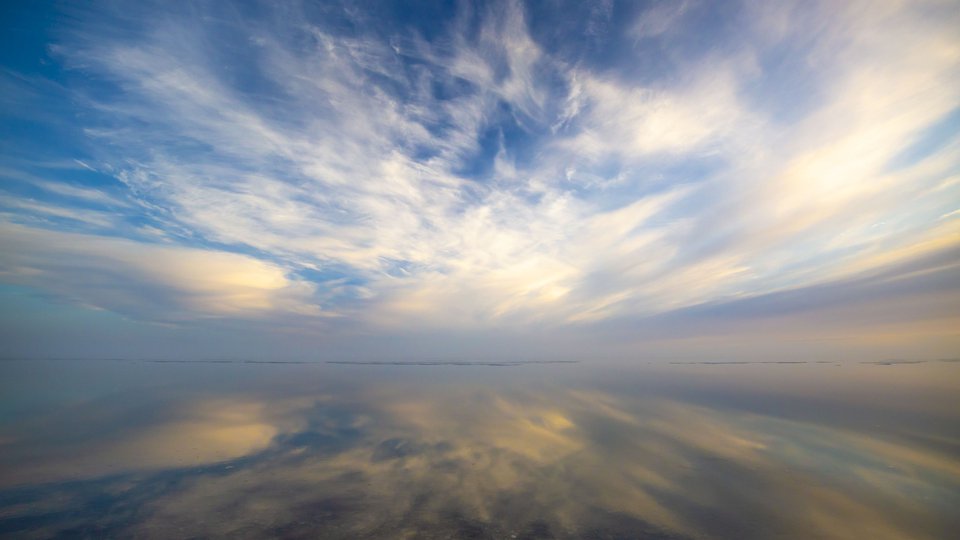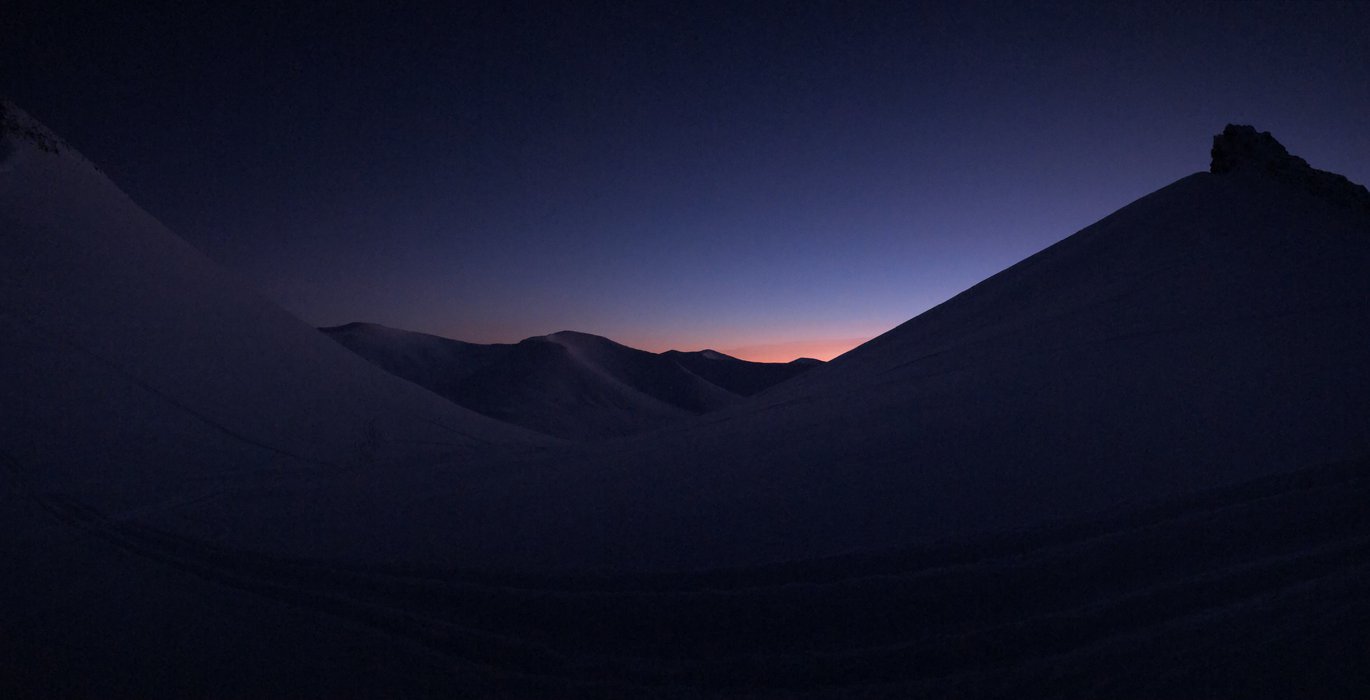
A shorter version of this piece was originally published by the Dark Mountain Project, a creative network centred on the Dark Mountain journal and dedicated to the search for stories with which to make sense of a time of ecological, social and cultural unravelling.
I. Penumbral: Outside
e are on top of the glacier because of the moon. It is being eclipsed, and we want to watch the way it disappears. Earlier, around noon, it peered from behind the mountains like a woken giant, like some open and peculiar eye. It lay low before dipping out of view behind the mountains across the fjord—we needed a higher elevation to see it.
A friend, Marita, has driven me up the glacier behind town on her snowmobile. We have come up to the pass at the end, overlooking Fardalen valley and the distant landscape beyond. When I imagine the feeling of launching into outer space, it’s the exact feeling I get from being a passenger on a snowmobile in the dark. There is no sense of control. Your breath fogs and crystalizes inside your helmet; you hold tight to the handlebars at your sides as you race forward and break through the wind. The tundra is uneven with snowdrift. The view is the same whether your eyes are open or closed.
Most of the sky is dark although it is two in the afternoon. It’s the end of January, and Svalbard is on its way out of polar night. We haven’t seen the sun in months, but we’re finally at a height where the southern horizon is present and beckoning, our bodies no longer closed in by the valley surrounding town. The plateau ridges of the mountains are silhouetted by a sunken sun, not yet risen or set. It feels as if we are stuck between two worlds: the sky behind us is a deepening indigo that holds the moon; the sky in front of us has the blooming colours of movement, of beginnings. We have reached a limbo, a boundary line which means “soon.”
It is the most colour we’ve seen since the beginning of November, when the sun went down one afternoon and never came back. We stand on the pass, hypnotized, once again reminded of those shades made from the sky, anticipating the brightness on its way back north. So much of living in the Arctic is defined by desire — in the winter, we want the sun to return; in the summer, we long for the dark shadows of night. We learn, forget, and remember a landscape that never stops shifting. Trying to memorize it is like trying to remember a dream from three nights ago.
The light is tricky up north. In the past, some explorers imagined entire mountain ranges where there was nothing, closed bays where there was actually open water. Even the reality of the landscape is not constant: the edges and masses of land transform with seasons and ice conditions. The satellite maps of the glaciers change every year as the ice calves, melts, shrinks. Any map of the Arctic is temporary, and at many points inaccurate: abstract representations of a place that’s nearly impossible to understand.
The discoverer of Svalbard, Willem Barentsz, was trapped by sea ice and stranded up here for ten months. When he was forced to overwinter with the rest of his crew, the men waited anxiously through the polar night for the sun. It was 1596. They were the first known people to reach the archipelago. Using wood from the ship, they built a cabin called “The Saved House” as winter closed in on them. That type of loneliness, that type of uncharted land—it made the darkness more pressing. They kept busy by setting traps for fur and food, checking the ship to see if the ice had loosened its grip. Sometimes they were completely inhibited by the cold.
An astronomer on board calculated the date of the sun’s first appearance over the horizon. I imagine them in this darkness hundreds of years ago, waiting through the months. When some members of the crew claimed to have seen the sun while walking in the area and checking fox traps, it was a full two weeks before the expected return. Barentsz called them crazy, until the next day when he saw the sun as well.

This mystery was solved almost 200 years later. What the men actually saw was a mirage, now known as the Novaya Zemlya effect. It occurs when the boundary between a layer of cold air and a layer of warm air in the atmosphere acts as a mirror, reflecting the sunlight and bouncing it around the curve of the Earth. What results is the illusion of the sun rising above the horizon earlier than it does in reality.
Living on Svalbard is a balancing act between dreaming and waking, and often the boundary is impossible to see: just as the sky and the mountains merge into the same shade of grey during a white-out. What you see is no longer what you know to be true. It’s no longer possible to measure distances by eye: a reindeer fifty metres away can actually be a kilometre across the valley. It’s the disappearance of our inherited measurements of time. Instead of hours of daylight and proceeding hours of darkness, it’s months of light followed by months of night. The idea of a calendar year falls apart. We are tied to the seasons rather than the individual months: polar night, the blue hour, the light period, midnight sun. The year seems to start whenever the snow falls and brightens the landscape, makes it new again. All of a sudden everyone is awake.
It’s a deconstruction—we are small, our human selves fall short. We are not made for these conditions.
I associate the North with the glass walls of my own limits. I have travelled to different northern territories, always alone, usually out of my element. When I worked for a summer in a mountain lodge with a husky yard in Finnmark—the northernmost county in Norway, with small villages scattered among open land— it was my first outdoor and physical job: my first experience with the contrasts of light and sound above the Arctic Circle, my first time working with dogs. I was insecure, clueless, and often cold, but I began to see a glimmer of a different self; some possible identity that I wanted to follow.
I followed this possible self to Svalbard, where I was forced to learn the language of a new landscape: how to assess avalanche or white-out risk, how to drive sled dogs, how to dress for prolonged periods of exposure to the cold. It’s a landscape that demands presence; awareness. There is nowhere to be but in the moment.
Below us, the edge of town is still visible. It’s not the smallness of the town that always surprises me, but the fact that it exists at all. What a place for a human civilization, for a grocery store and a bank and a movie theatre. In the dark season, the settlement radiates the only light for 40 kilometres, until the Russian mining town further out on the fjord. It’s as if we are on the threshold of an empty room.
I cannot figure out how anyone could decide when to leave a place like this, to say they’ve had enough of it: the transformations, the quiet, the dimension of light, the rejection of noise and politics and dizzying systems that tangle the rest of the world.
There is no known native population on Svalbard. Today, there are only rumours and ideas of people who could have been here before Barentsz’s official discovery of the archipelago in 1596. The Icelandic Annals of 1194 state that Vikings discovered a place called Svalbardi, a name meaning ‘land of the cold coasts.’ But this mysterious ‘cold coast’ was never documented—was it the edge of the sea ice? The coast of Greenland? Or could it have been the edge of Spitsbergen — the largest island of the Svalbard archipelago? The Russians historicize the discovery of Svalbard as a feat accomplished by the Pomors in the 14th century. In the 1980s, an archeologist travelled down the west coast of Spitsbergen collecting what he thought were arrowheads. After years of writing a thesis about a Stone Age settlement existing on Svalbard, further research determined that these ‘arrowheads’ were the results of frost and geology.
No one truly belongs here. While some of the mountains on Svalbard are hundreds of millions of years old, people have known about the archipelago for less than 500 years. Its status as a No Man’s Land, along with the Spitsbergen Treaty that names Norway as the sovereign nation, dictate that nobody can be born or buried on Svalbard. It is meant to be a temporary place: the administrative centre, Longyearbyen, is filled with seasonal workers; people who come to experience a year at the top of the world and then return to the lives they had before. I think of the bird cliffs all around the fjord: thousands of migratory birds arrive in the summer and build their nests on the rock faces, tucked away from foxes and bears. At the end of the season, they jump from the cliffs with their young and fly south.
Outside of town, I see only space: the one road leading into the valley thinning into the east; the wide valley of Adventdalen; the wind-packed snow over the frozen riverbed like flat ridges of frosting spread from a butter knife. This time of year, when the dark season is lifting, brings a recollection: suddenly, the outlines of the mountains are visible when only a week ago they were obscured. I’ve forgotten and remembered entire mountains before. I cannot figure out how anyone could decide when to leave a place like this, to say they’ve had enough of it: the transformations, the quiet, the dimension of light, the rejection of noise and politics and dizzying systems that tangle the rest of the world.
Anyone can look at this landscape and imagine it as another planet: the brutality of one sharp-peaked mountain after another, the heavy-handed contrasts between light and dark, the animated sky. Northern and lunar landscapes inspire the same type of awe. They are not comprehensible. They are lonely. They reveal so little of themselves that it seems like their existence could be nothing more than imagined. As I watch a shadow start to shave away at the moon, I catch myself holding my breath, as if the same thing is happening to where I’m standing; as if I could blink once and simply be gone.
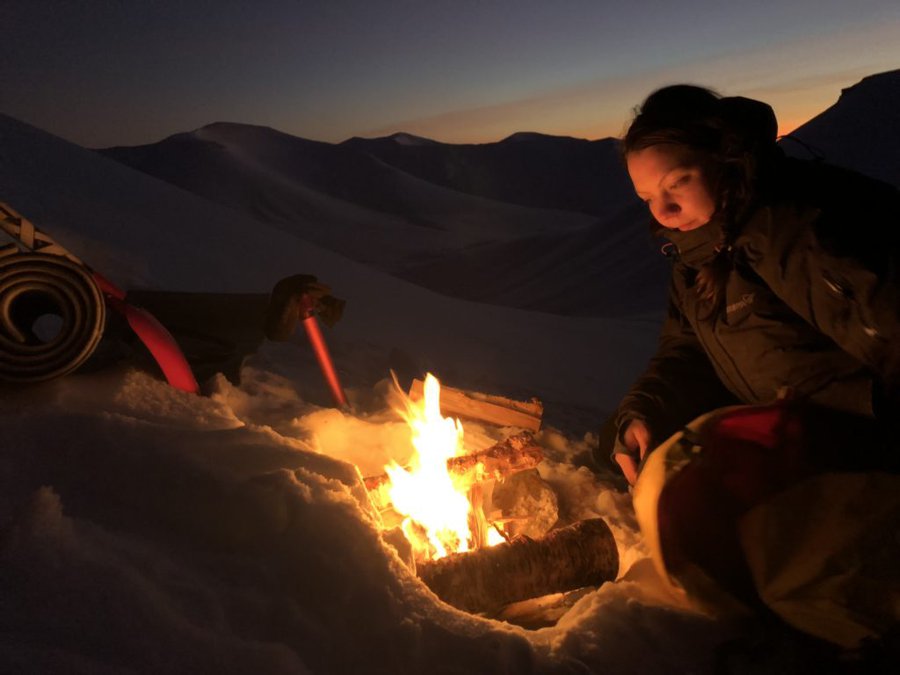
II. Partial: Submergence
In some places, the snow is up to my knees, and it brightens the landscape in a way that makes it seem awake after a season of hibernation. Other people begin to arrive on snowmobiles or skis, packs strapped to their backs, cameras in hand. Everyone looks up at the moon, now red and suspended over the lights of the town below.
I run up the side of the mountain, taking breaks to catch my breath. Running in deep snow is nostalgic: mine is the clumsiness of a child trying to find the right footing, the carefree feeling of knowing a possible fall will be soft and cushioned.
Marita is at the base of the mountain, unloading wood to make a fire. I sit on a tower of rocks near the top and watch the land – I’ve always loved the long view. If the landscape is a body, the plateau ridges of the mountains are shoulder blades, the descending slopes like dresses held down against the wind. The stars are out, the wind is gone.
I still my own breathing and everything is silent. The north is absorbent. It is so vast and open that everything seems to shrink in comparison. Sometimes, on the windless days, even the concept of sound disappears. For a few minutes, everyone else on the mountain seems to acknowledge the rarity of a space so quiet, and they too fall silent.
In uninhibited spaces, sound travels far. I hear a distinct conversation between two people at the bottom of the mountain. I hear the sound of Marita peeling off pieces of wood with her knife. When fur-trappers lived in cabins in remote parts of Svalbard, some claimed they could hear other hunters from across the fjord, kilometres away. I imagine the sounds spreading the way clouds do over the sea in early summer, when the snow cover is melting and evaporating. They drift, disperse, dissolve.
The sky is dissolving the moon. Thin slivers are disappearing, making the blood-red crescent smaller and smaller. It looks as if the moon has been pulled underwater. Meanwhile, the world continues. A line of snowmobile lights moves evenly towards the west coast, the headlamps of lone skiers search the sides of the mountains. We are a group of spectators sitting on the sidelines, angled toward the eclipse on the northern horizon. Clouds are drifting in from the west, and the afternoon plane is coming in for landing, sailing above the black waters of the fjord below.
I run down the mountain side in long, bounding steps. I wonder if this is the feeling of moving in zero gravity. I dig my heels into the snow to make stairs, and then I give up and slide on my bottom the rest of the way. The snow yields so easily, brings me down.
At the base of the mountain, Marita has dug a hole that can hold a fire and shelter it from the wind blowing in from the north. She is trying to light the small strips of wood she has cut, but they don’t catch. I try blocking the wind with my body, and eventually we manage to get a small fire going. It burns for a little while, then is extinguished again. We turn our attention to the landscape instead.
‘I almost feel more balanced in the dark,’ she says, after a long silence.
‘I know, it’s nice to finally have a quiet period. During midnight sun there’s too much energy, activity, socializing.’ I think of how restless I felt whenever the light didn’t fade. There was never a natural close to the day.
‘It was always so draining. Everything feels calmer now.’
Polar night shortens the scope of what we see physically, but it turns our gaze inwards. I think of the sky as a mirror, sometimes reflecting the sun’s rays and bending them into an illusory sunrise; sometimes reflecting the person who gazes at it. Without a view of what is around us, we turn, instead, to ourselves: memories, dreams, thoughts. The locals on Svalbard call it ‘the dark time,’ or ‘the quiet period,’ using it as time for personal projects. Some people knit sweaters; others build furniture; a few write books. Some leave the island completely, go south to somewhere warm and visited by the sun.
Initially, it took discipline. In the dark, the body can sleep and sleep. It can be tempting to drink more, move less. Small shadows of doubt, anxiety, sit at the doorstep of the mind, waiting to be let in. We try to maintain a normal routine of eating, sleeping. Suddenly we have to work for things that have always come naturally.
‘Do you hear that?’ Marita asks. It’s absolutely nothing. She’s talking about the silence.
‘Do you think there’s anything else out there?’
Here, in the real depths I realize that our civilizations are more fragile than we know. Every time a ground blizzard destroys the roads, or apartment buildings are closed due to avalanches, or ships are stuck in sea ice, it feels like we’re occupying a place that is barely tolerating us.
I moved north to submerge myself in a place I was captivated by but couldn’t understand. I once saw an exhibition about the Arctic in a Danish museum that archived countless tales of successful and failed expeditions, the race to the Pole. This was the first time I was taken by the north: I stepped inside one of the installations, a small room that simulated the experience of standing in a storm during the polar night. Everything was black, the sound of gale-force winds blasted through speakers around the room. It felt like going under; like the constriction in your chest when taking a breath and diving into the deep.
Here, in the real depths I realize that our civilizations are more fragile than we know. Every time a ground blizzard destroys the roads, or apartment buildings are closed due to avalanches, or ships are stuck in sea ice, it feels like we’re occupying a place that is barely tolerating us. At any second it could change its mind. Maybe it’s good to be shrunk down, overshadowed; to come face to face with elemental forces that will always outdo us.
Others before me have submerged themselves. When the Austrian painter Christiane Ritter spent a year on Svalbard with her hunter-trapper husband, they lived in a cabin on one of the northernmost reaches of Spitsbergen. Their nearest neighbours were some hunters in fjords a couple of days’ journey away. Upon being retrieved by a passenger ship at the end of her stay, Ritter felt alien to the culture she’d always known. The savoury foods and luxury items on board were not as comforting as they used to be. Other passengers were baffled by her love for a place that, she wrote, ‘lies so black and bleak between mist and ice and water.’
When she first went North, Ritter was completely out of her element: she had no experience working outdoors; she had never lived in the wilderness; she had never been anywhere in the Arctic. Nevertheless, she adjusted, acclimatized, and learned new ways of living. She transformed with the landscape, and maybe that’s how the place claimed her — to the point where she extended her time on the island and felt lost when she finally left. This is the common love story between a person and Svalbard. It happens all at once and without a grand announcement, but suddenly no other place feels more compelling.
On Svalbard, we have all wandered from the places we were brought up in. We exist at a latitude that hardly supports us. We sometimes think we’re dreaming, or wonder if we’re on a different planet. Maybe we’re hoping we are. Nevertheless, we have been consumed; we have fallen in love with the boldness of the fjords, the clicking of ice against the shore, the pastel brushstrokes against the sky before the first sunrise of the year.
Whenever I leave this place for somewhere else I am shocked. I am exposed to more sensory information, more people and options and sound. I realize my clothing is out of place and impractical for a city. I remember I have to lock houses and cars. I no longer use the same amount of energy or effort during the day. The confidence I have collected on Svalbard seems to slip away, and suddenly I’m back at the beginning, or halfway between two identities.
Half of the sky holding the moon is a grey-blue twilight the colour of the sea, and the other half deepens with the fading colours of the sunset. Behind one of the peaks, a smudge of aurora crescendoes and releases. It is half past two and the moon is going, fading into the shadow of the Earth. When I see darkness like this and the way it blends with open spaces, I think it’s no wonder that explorers imagined mountain ranges, sunrises, refuge. How could anyone exist up here and be sure of what they know of reality, what they know of dreams?
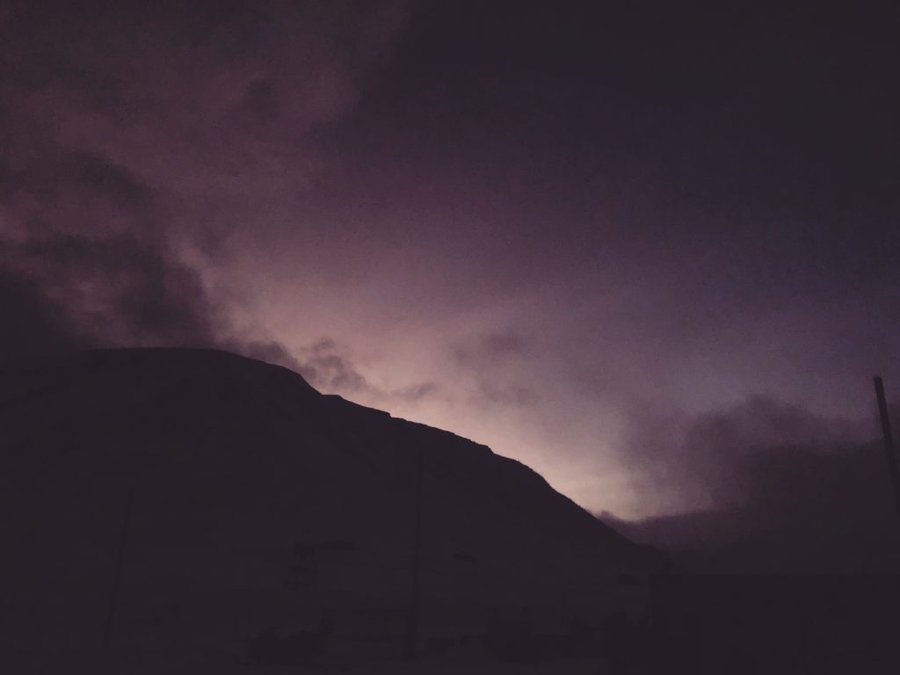
I. Totality: Within
‘It’s going,’ someone on the mountain says, and everyone looks at the moon, which is nearly gone, swallowed by the sky. It is not completely invisible, but heavily shaded. The edges are still somewhat present, a slightly discolored portion of the sky like the outline of a celestial ghost.
Once the moon is in full shadow, Marita and I walk halfway down the glacier and find a cave. Inside the opening is a ladder, leading straight down into the depths, where it stops and the ground levels out, then drops again, this time without a ladder, where all we can do is slide down, feet first, the beam from the headlamp reflecting from the glittering walls of snow. It is like being unborn, descending into the ice cave: returning to a primordial state, crawling through the opening in the glacier and into a region without time, without light. We leave the world we know so well; the new land begins here.
What to know about glacial caves:
- They are completely without light. It is the darkest dark. Once inside, there is no space in the ice and snow where the light pushes through. Your eyes will never adjust. It is as if someone has tightened a black lid over everything.
- Each cave is a meltwater channel; the path all of the glacial water moves through in the summer. For this reason, the structures of the caves are constantly changing. The glacier moves and melts each year, the water carves the ice again and again.
- The ice of a glacier is thousands of years old, snow compressed into ice by an unimaginable amount of time and pressure.
Marita and I move through the cave as if it is a cathedral. The chamber is winding — smooth arches of ice disappear over us. Every time we think we’re reaching the end, we round a corner and enter another space with vaulted ceilings: a strange and crystalized labyrinth. We have to walk slowly, necks craned, faces pointed upwards, so the beam from the headlamp ignites the entire height of the cave, which is sometimes three or four metres. The ice is dry to the touch and iridescent: blue in some places, white in others, and often clear—the colour shifts with the angle of light. There is no way to tell the depth of the ice, and sometimes the boundary between ice and air is difficult to see.
There is not only ice here. To walk into a piece of the landscape, to be within it completely, is like walking in to someone else’s memory. When we examine the walls, we see things the glacier has been carrying for thousands of years: sand, pieces of stone, fossils. We find one fossil of a round leaf, another of a creature resembling a fish. Talking to a geologist, months after this night of the eclipse, I will learn that in the Devonian period, 400 million years ago, most of Svalbard was underwater—the mountains not yet formed—and pieces of the archipelago travelled from as far as the equator. The Earth breaks, drifts, remembers.
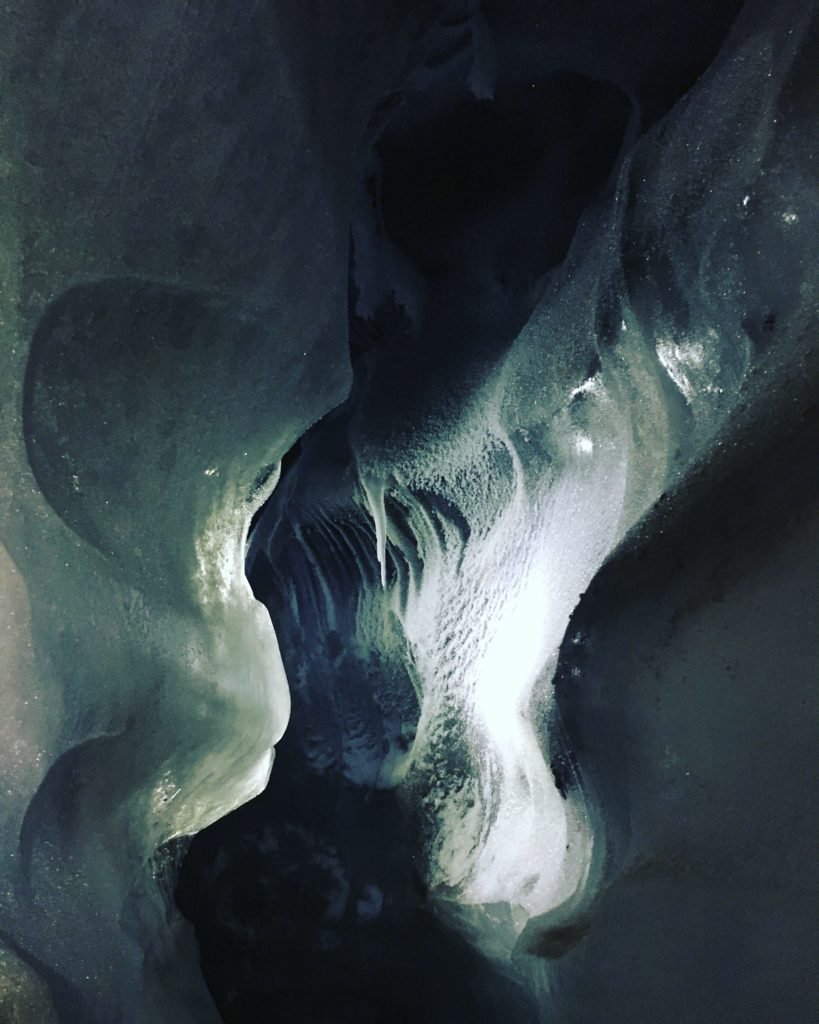
Finally we reach the end, where the corridor narrows and tapers off, where it would be necessary to lie flat on the ground in order to inch forward. The cave is warm compared to outside, maybe two degrees above freezing. No wind; no exposed air. We sit on the ground, backs pressed against the ice, and switch off our lamps. Then: an absorbing blackness.
Marita and I decide to be completely quiet and keep still. To sit in a contained and silent darkness like this is to waver between tranquility and fear. Picture a sea divided: on one end is a storm, on the other is water as flat as a mirror. Suddenly, there are no visible stimuli; there is no world. It feels as if I am alone with myself, as if I am on the edge of non-existence. No physical form or body, just untethered consciousness. I am eclipsed by the glacier in the same way I have been engulfed by other elements of the north: the way my energy collapses with the dark season; the way I have to train my body to remember how it should function when normal demarcations of time are obliterated.
We stay in the same position for what feels like hours. There is no way to measure how much time is passing. I remember a book I read about a Canadian explorer, Richard Weber, attempting to reach the North Pole. He started out across the ice sheet on skis, only to eventually realize that the sheet was drifting in the opposite direction. He skied for kilometres and stayed in the same place. Similarly, it seems that some people who explore northern territories remain in these places, even when their bodies leave. In their minds, they’re forever walking on that sheet of ice, their mental landscape seized with the northern dream of solitude, silence, a simplified self.
And then: a snap somewhere above, a falling piece of ice. The spell is broken, I’m dragged to the surface. I feel the incessant pounding of my human heart.
Soon, we will have to crawl out. We have seen enough. It is not within our capacity to stay. Like waking from a dream, it is not our decision when or if we can return to these regions. It is not even our space to map. We rub our eyes, steady ourselves, walk back towards the opening while trailing our fingers across the ice. At the entrance, there is a framed piece of twilight. Maybe the moon is no longer lost. Maybe it is emerging again, in the same way that Svalbard is emerging from the polar night: a curtain opening and returning the world to what it had been before. We pull ourselves up into whatever is waiting, make our way toward the last of the shadows.
Bibliography
Ritter, Christiane. A Woman in the Polar Night. Translated by Jane Degras, George Allen & Unwin Ltd., 1958.
Kelsey Camacho lives in Longyearbyen, Svalbard, where she is working as a guide on dogsleds and on the sea. She spends the dark season with books and candles. Her work has appeared in Nowhere magazine, Proximity, Entropy, and elsewhere.

